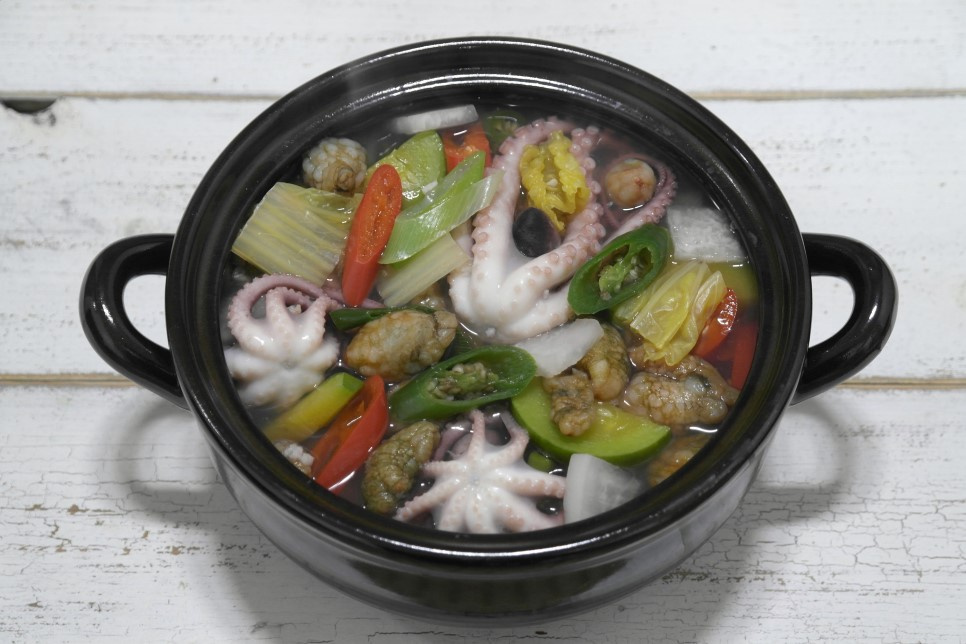
How to make a hearty and warm healthy octopus hot pot
I ate a lot late last night and thought I wouldn't be able to sleep well if I slept without digesting, so I went to a large mart near my house for a walk.
There are so many succulent plants at home that I think I've been thinking about "buying a shelf and organizing it" for more than a month, but I finally bought a shelf at a large mart.
I bought a shelf, bought blankets and pillows from a bedding store next to it, and went to the food section on the first basement floor, and my cart was already full.
I had no choice but to buy bulky food first because I thought I should buy it last.
If you go to the food section of the large discount store late in the evening, there are foods that need to be sold quickly due to their short expiration date, or foods that need to be sold quickly before they become less fresh, but I bought octopus and arrogance at a low price.
Actually, I was going to buy squid at a reasonable price with the intention of making squid radish soup, but the squid was already sold out, and there were only octopus.
Instead of pheasants, there were some octopus that sold chicken at a low price, so I bought octopus instead of squid.
The arrogant next to the octopus is also sold at a low price, so I bought it together and put the arrogant in it the next day to make octopus lotus potang.
"Instead of squid, octopus soup instead of radish soup with squid"
This is how to make octopus lotus pot soup that was so delicious that you can't think of squid radish soup.
2 serving
Within 30 minutes

동주
- Ingredients
-
-
Octopus3ea
-
a haughty boy200g
-
Depory5ea
-
Cabbage2piece
-
Cheongyang red pepper1ea
-
Red pepper1ea
-
onion1/2ea
-
leek1/2piece
-
Young squash1/3ea
-
Radish1piece
-
crushed garlic1T
-
Soy sauce1T
-
Saltlittle
-
- Cooking Steps
-
STEP 1/10Cut radish at intervals of 0.3cm, cut cabbage in half and cut it in a shape similar to radish, and cut zucchini into half-moon shapes at intervals of 0.5cm.
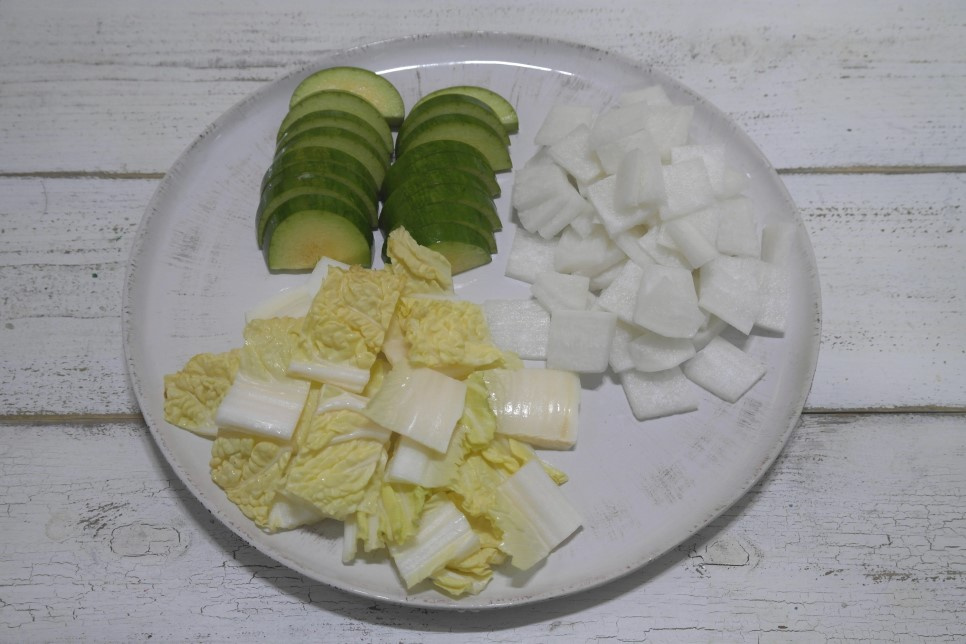 STEP 2/10Chop the onions at 0.5cm intervals and chop the green onions, cheongyang peppers, and red peppers diagonally at 0.5cm intervals.
STEP 2/10Chop the onions at 0.5cm intervals and chop the green onions, cheongyang peppers, and red peppers diagonally at 0.5cm intervals.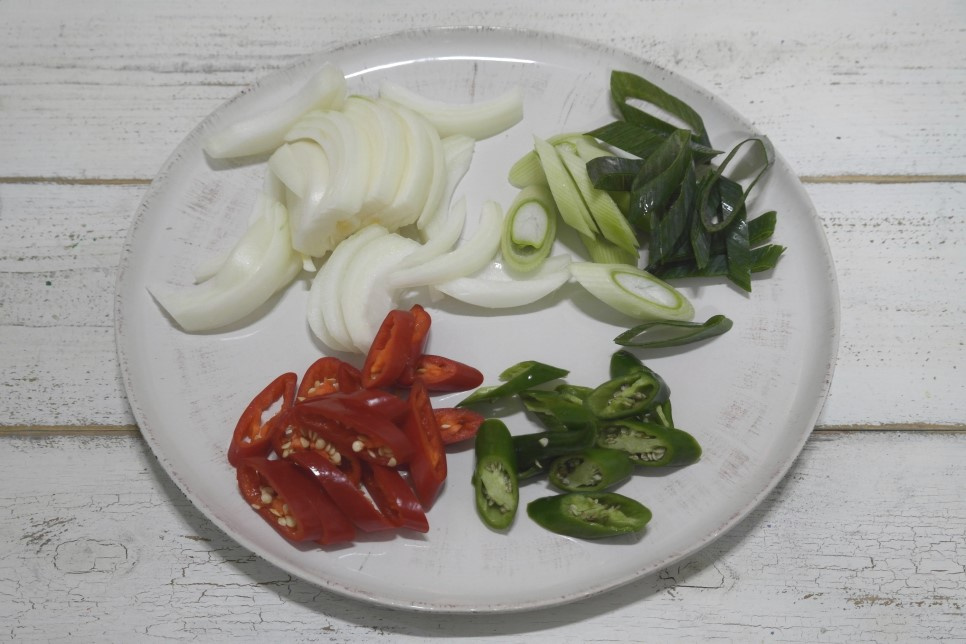 STEP 3/10Scrub the arrogance with thick salt and wash it clean in running water.
STEP 3/10Scrub the arrogance with thick salt and wash it clean in running water.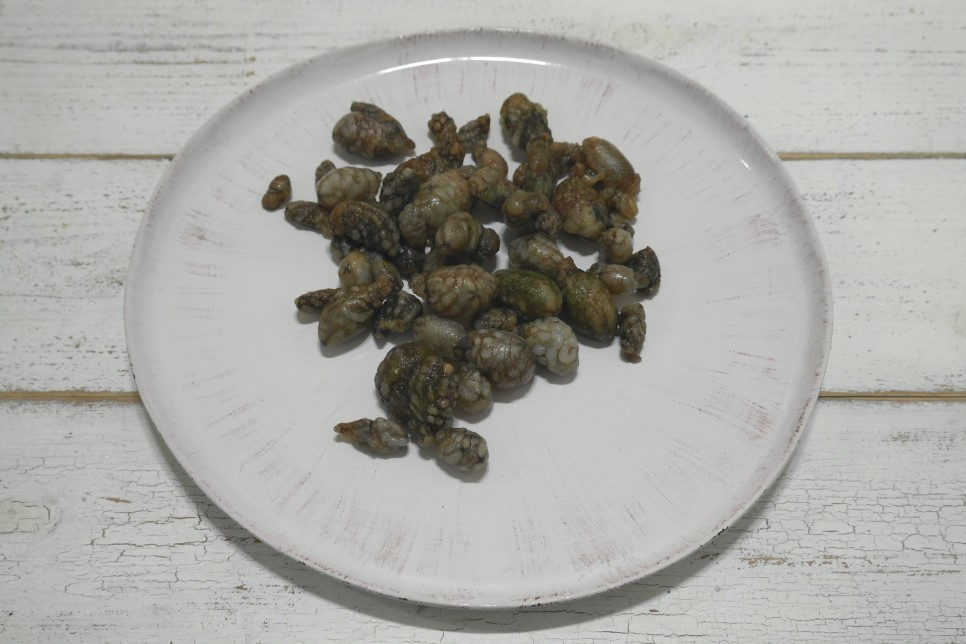 STEP 4/10Scrub the octopus with flour, remove the eyes, mouth, and intestines, and wash it clean in running water.
STEP 4/10Scrub the octopus with flour, remove the eyes, mouth, and intestines, and wash it clean in running water.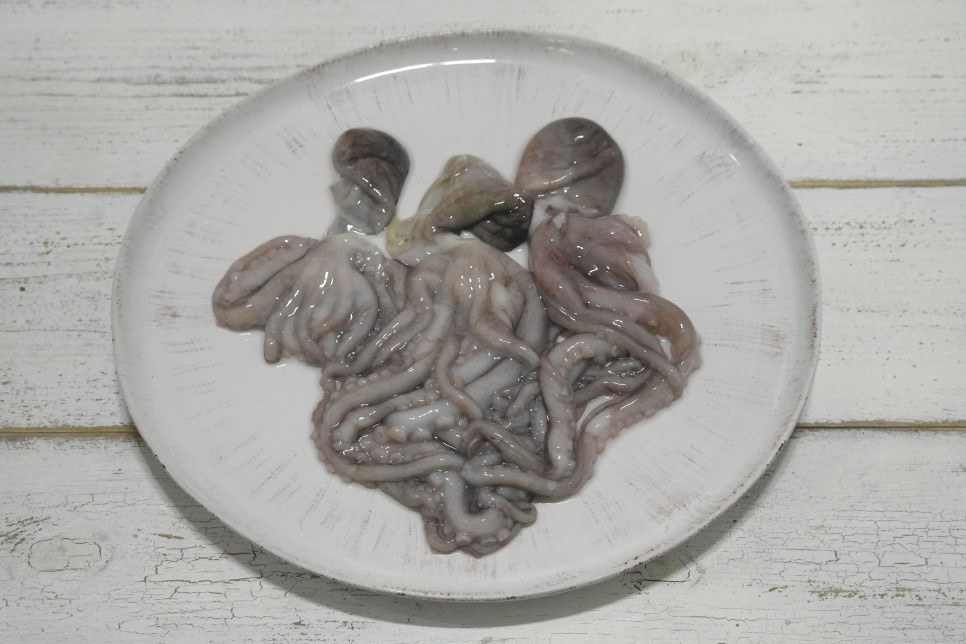 STEP 5/10While preparing the ingredients, boil the dipori in cold water and scoop it out.
STEP 5/10While preparing the ingredients, boil the dipori in cold water and scoop it out.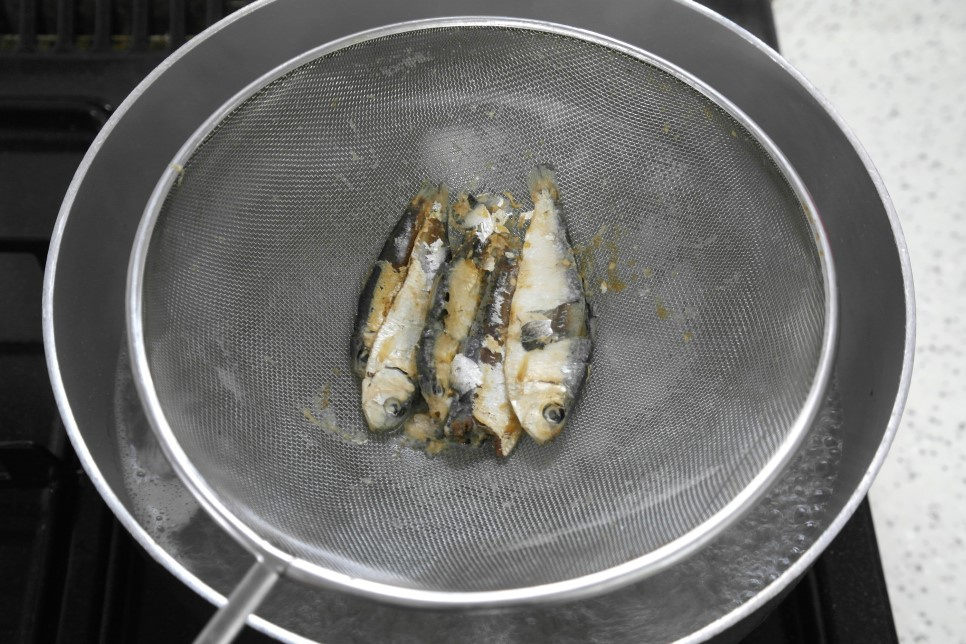 STEP 6/10Boil radish and swaggy radish in the prepared broth.
STEP 6/10Boil radish and swaggy radish in the prepared broth.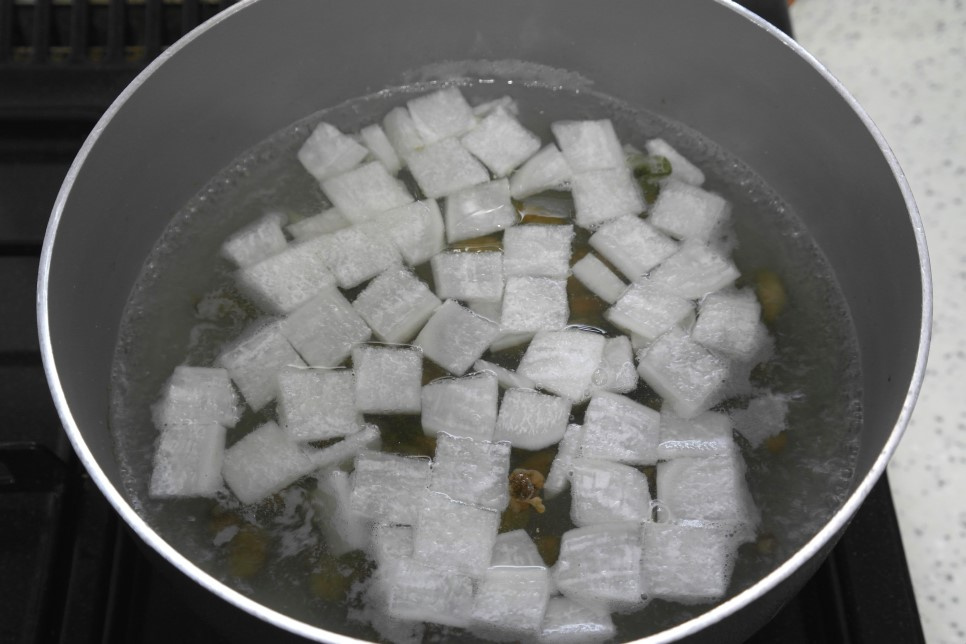 STEP 7/10When the radish starts to cook transparently, add zucchini and boil.
STEP 7/10When the radish starts to cook transparently, add zucchini and boil. STEP 8/10When the zucchini is half cooked, add octopus and boil.
STEP 8/10When the zucchini is half cooked, add octopus and boil.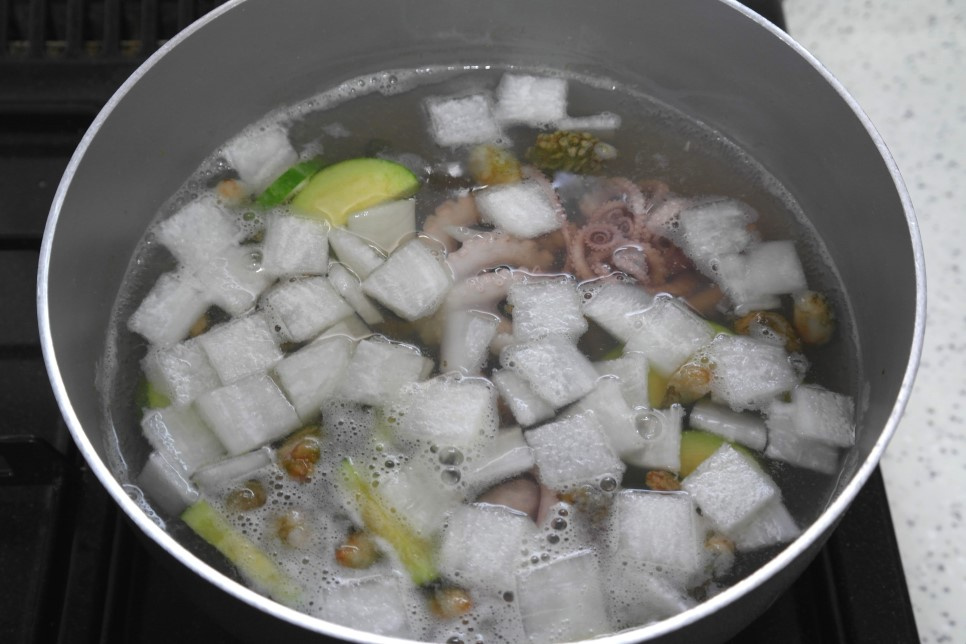 STEP 9/10When the octopus is cooked, add cabbage leaves, 1T of minced garlic, and 1T of soy sauce and season with salt.
STEP 9/10When the octopus is cooked, add cabbage leaves, 1T of minced garlic, and 1T of soy sauce and season with salt.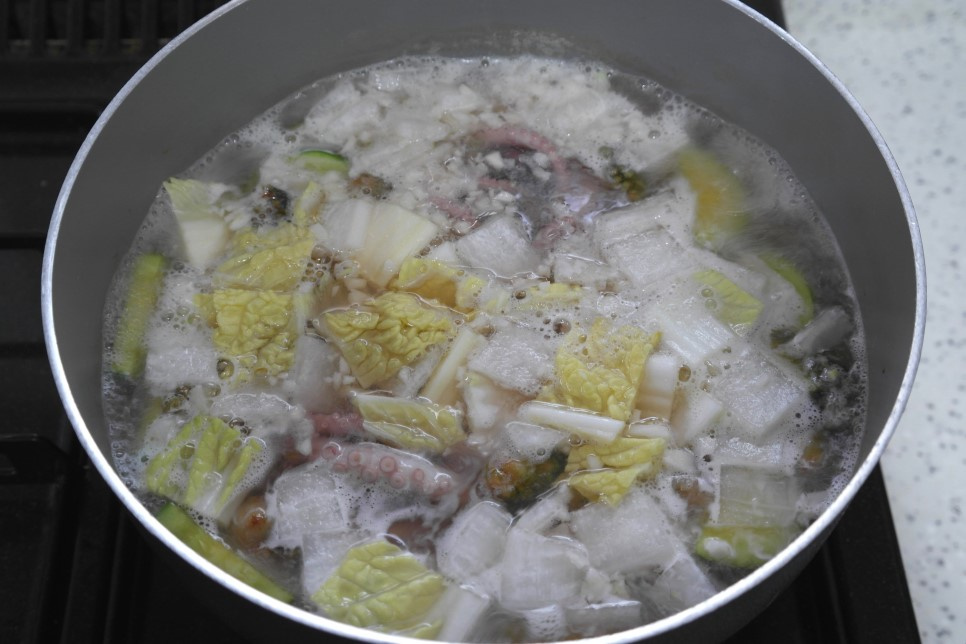 STEP 10/10Add onions, green onions, cheongyang red pepper, and red pepper at the end and boil it for another 30 seconds to complete the octopus lotus pot soup.
STEP 10/10Add onions, green onions, cheongyang red pepper, and red pepper at the end and boil it for another 30 seconds to complete the octopus lotus pot soup.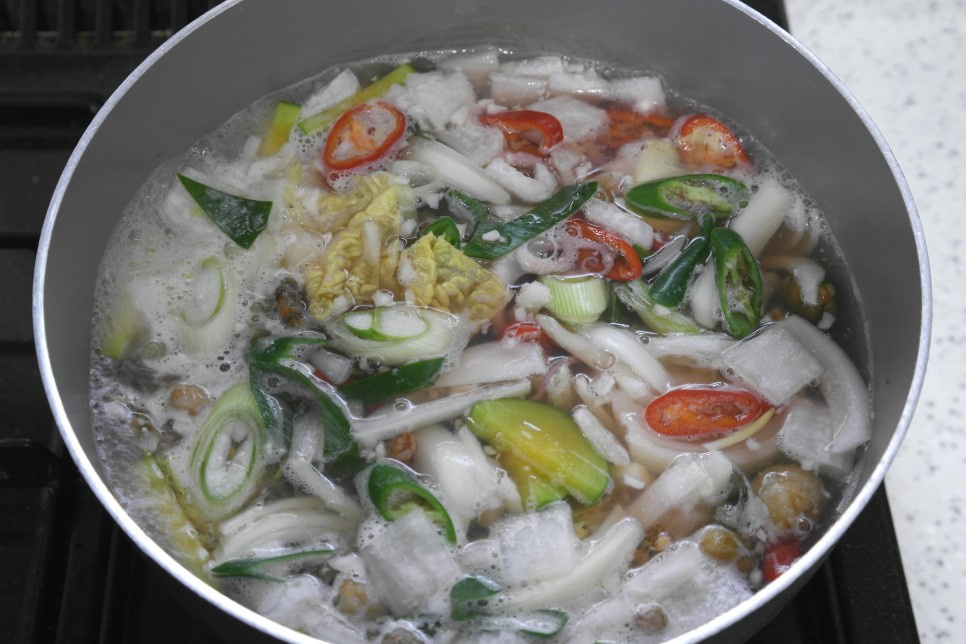 It is really important to control the boiling time because octopus and other vegetables are boiled together, including octopus. Radish and Omani need to be put in the finished broth from the beginning to taste the soup. If you boil octopus for a long time, it is recommended to boil it at the end. If you want a refreshing, spicy, and spicy taste, you can add red pepper powder. But I wanted a clean and cool taste, so I only added onions, green onions, cheongyang peppers and red peppers, and didn't add chili powder separately. I added radish, an important vegetable that tastes like soup, as well as leftover zucchini and cabbage leaves, but radish is a must, and if you don't have zucchini and cabbage leaves, you don't have to boldly put them in. However, if zucchini and cabbage leaves are added, the color will come alive.
It is really important to control the boiling time because octopus and other vegetables are boiled together, including octopus. Radish and Omani need to be put in the finished broth from the beginning to taste the soup. If you boil octopus for a long time, it is recommended to boil it at the end. If you want a refreshing, spicy, and spicy taste, you can add red pepper powder. But I wanted a clean and cool taste, so I only added onions, green onions, cheongyang peppers and red peppers, and didn't add chili powder separately. I added radish, an important vegetable that tastes like soup, as well as leftover zucchini and cabbage leaves, but radish is a must, and if you don't have zucchini and cabbage leaves, you don't have to boldly put them in. However, if zucchini and cabbage leaves are added, the color will come alive.
- Cooking review
-
4.25score
-
 148*****scoreI really enjoyed the meal.2020-04-11 21:06
148*****scoreI really enjoyed the meal.2020-04-11 21:06 -
 358*****scoreIt's less refreshing because there's no radish My parents say it's delicious. Thank you2019-08-17 12:10
358*****scoreIt's less refreshing because there's no radish My parents say it's delicious. Thank you2019-08-17 12:10 -
519*****scoreThe recipe was easily explained, so I made it delicious and ate it.2019-07-24 19:42
-
 yun**scoreI really enjoyed the food.2019-07-22 20:42
yun**scoreI really enjoyed the food.2019-07-22 20:42
-
- stir-fried Rice Cake Recommended recipe
-
-
1
 Super simple "Jongwon Baek style tteokbokki" (feat. the end of t4.94(53)
Super simple "Jongwon Baek style tteokbokki" (feat. the end of t4.94(53) -
2
 Jjajang tteokbokki. A good jjajang powder dish for a kid's snack4.91(120)
Jjajang tteokbokki. A good jjajang powder dish for a kid's snack4.91(120) -
3
 Soup tteokbokki - Soup of tteokbokki from a snack bar in front o4.89(212)
Soup tteokbokki - Soup of tteokbokki from a snack bar in front o4.89(212) -
4
 [Simple snack making] Garlic butter tteokbokki, garlic tteokbokk4.88(48)
[Simple snack making] Garlic butter tteokbokki, garlic tteokbokk4.88(48)
-
- Japchae Recommended recipe
-
-
1
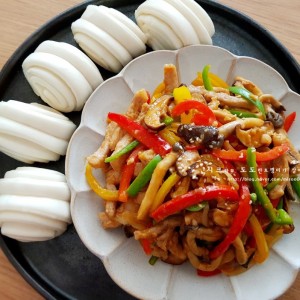 Red pepper japchae. Golden recipe for red pepper japchae4.97(36)
Red pepper japchae. Golden recipe for red pepper japchae4.97(36) -
2
 Meatless japchae (paprika japchae with only vegetables)4.88(16)
Meatless japchae (paprika japchae with only vegetables)4.88(16) -
3
 How to make japchae deliciously! It's too simple4.85(39)
How to make japchae deliciously! It's too simple4.85(39) -
4
 Fish cake japchae, fish cake and chives, super simple japchae4.70(27)
Fish cake japchae, fish cake and chives, super simple japchae4.70(27)
-